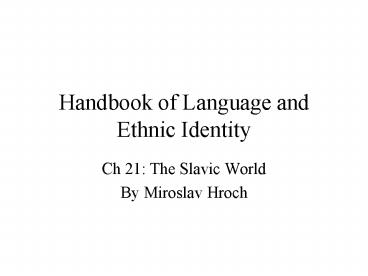Handbook of Language and Ethnic Identity - PowerPoint PPT Presentation
1 / 17
Title:
Handbook of Language and Ethnic Identity
Description:
Handbook of Language and Ethnic Identity Ch 21: The Slavic World By Miroslav Hroch Divisions among Slavs Linguistic: West: Poles, Czechs, Slovaks, Sorbs East ... – PowerPoint PPT presentation
Number of Views:149
Avg rating:3.0/5.0
Title: Handbook of Language and Ethnic Identity
1
Handbook of Language and Ethnic Identity
- Ch 21 The Slavic World
- By Miroslav Hroch
2
Divisions among Slavs
- Linguistic
- West Poles, Czechs, Slovaks, Sorbs
- East Russians, Ukrainians, Belarusians
- South Slovenes, Croats, Serbs, Macedonians,
Bulgarians
- Religious
- Catholic/Protestant West Slavs Ruthenians
(Greek Catholics), Croats, Slovenes - Orthodox East Slavs Serbs, Bulgarians,
Macedonians - Muslim (some) Bosnians
3
Neighbors among the Slavs
- Balts Lithuanians, Latvians
- Finno-Ugric Hungarians, Estonians
- Romance Romanians
- Albanians
4
Pre-nationalist empires
- The Slavs inhabited three multiethnic empires
with three administrative languages - Tsarist Russia (Russian)
- Ottoman (Turkish)
- Habsburg (German)
- Except for the Russians
- All Slavs had a national revival
- Slavic languages codified early 19th c
- Slavs were primarily low status, lacking
political power
5
Czechs
- Czech language was used as a literary/administrati
ve language 14th-16th c - Late 17th c Czech was replaced by German in
public sphere, upper classes Germanized - Early 19th c Dobrovský writes grammar of Czech
for posterity Jungmann demands rights for
Czech language Czechs come to understand
themselves as a nation in mid-19th c
6
Slovaks
- Upper classes were mainly Magyarized or
Germanized - Since 16th c Czech was used as literary language
- Ethnic identity divided between Magyar (1000 yrs
in that kingdom), Czech (Protestants), Slovak
(Catholics) - 1840s Ludovit Stur creates literary Slovak, but
it does not gain real status until Czechoslovakia
is established in 1918
7
Sorbs
- A small group (approx 40-100K) in the eastern
part of Germany, differentiated into two
linguistic varieties - Upper Sorbian (larger, closer to Czech)
- Lower Sorbian (smaller closer to Polish)
- Agitated for recognition in 19th c, did have some
protections under East Germany (DDR), but all
speakers are now bilingual and language is
threatened
8
Croatians
- Kingdom was joined to Hungary (Latin), Dalmatian
part also used Italian - 16th-17th c first literary publications in
Croatian - Most Croats speak a dialect shared with Serbian
1850 agreement on common Serbo-Croatian written
in two scripts - 20thc rejection of Serbian dominance, since 1980s
independent Croatian state and language
overemphasizing differences from Serbian
9
Serbs
- Orthodox Church an essential component of
identity - Ottoman empire late 14th-19thc, followed by
independent Serbia - Vuk Karadzic led movement for Greater Serbia
stressing linguistic identity
10
Slovenes
- 1840s a group of SSl dialects in the Alps formed
the basis for a literary language - Previously weak ethnic identity based on local
valleys, strong tendency toward assimilation - Late 19thc national mobilization part of
Yugoslavia in most of 20thc now separate state
11
Bulgarians
- 9thc conversion to Orthodoxy and use of Old
(Church) Slavonic, followed by Greek assimilation
under Ottoman Empire - 1860s formation of literary language mostly based
on E dialects 1878 Bulgarian nation/state
emerges - Continuing struggles over what/who is/isnt
Bulgarian (in Greece, Macedonia, Serbia)
12
Macedonians
- Macedonian nationalism begins with establishment
of Bulgarian state - Macedonians we are independent
- Bulgarians no, they are West Bulgarians
- Greeks no, Macedonia is part of Greece
- Serbs no, they are Bulgarized Serbs
- Macedonian literary lang est in 20thc, a republic
of Yugoslavia and now an independent state
13
Poles
- Medieval Poland-Lithuana used Polish Latin
- Polish nationalism emerges when Poland is divided
by conquerors (Prussia, Russia, Austria), under
assimilation pressures (Germanification,
Russification) - Cultural support from wealthy Polish diaspora in
W Europe
14
Ukrainians
- After dissolution of Poland-Lithuania, Ukrainian
territory divided among Habsburg and Russian
empires - Russians regard them as Little Russians, but
Austrians allowed Ruthens to develop their
culture - Ukraine is big, literary language based on
central dialects - After 1917, most of Ukraine was in USSR, subject
to Russification, remainder in Poland was later
seized by USSR, patriots were persecuted
15
Russians
- Literary/administrative language since middle
ages, Russian state since 15thc - Since late 19thc (under tsar and continued in
USSR) Russification of non-Russian ethnic groups
in the multiethnic empire
16
Summary
- Three Empires
- Habsburg Germanification until 1860s, some
improvements thereafter - Ottoman Identity keyed to religion, not language
- Russian Persecution of non-Russians Ukrainian
Belarusian considered dialects, Polish persecuted
for political reasons, but slavophiles supported
other W and S Slavs
17
Summary, contd.
- Czechs Poles had literary languages since
middle ages - Others had to codify literary language based on
one or more dialects - National movements purified languages,
distinguished them from ruling state or old
church languages - Strong identity of language with social status
and strong identification of ethnicity and
language






























